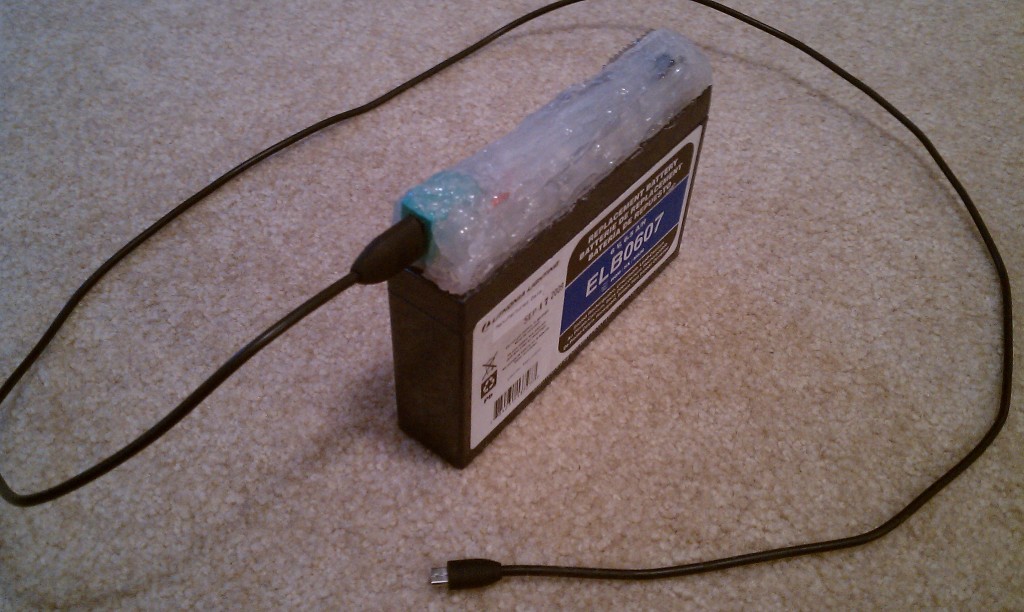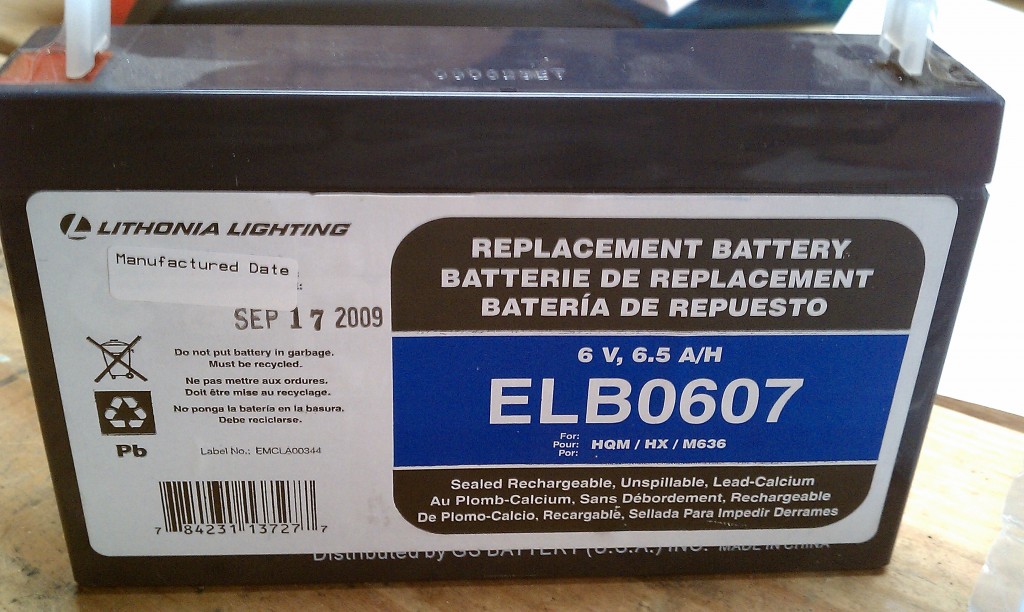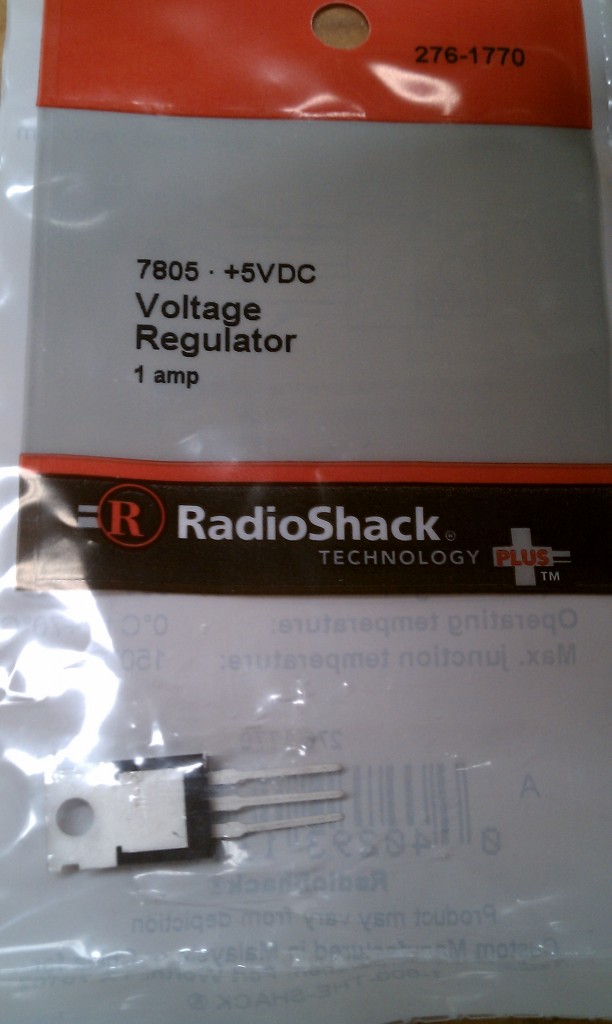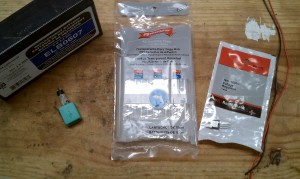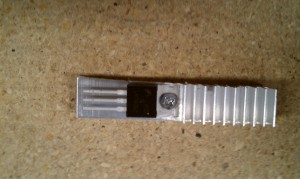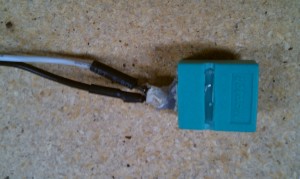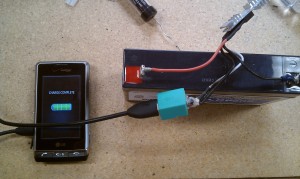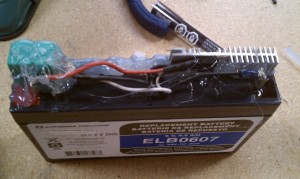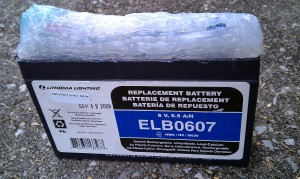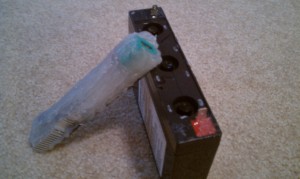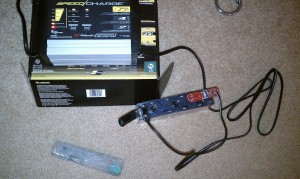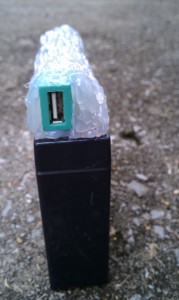I was getting ready for a long train ride from KY to DC and found out there aren’t any AC outlets for coach seats! A 15hr ride isn’t too bad when you have a smart-phone; then again, the stock battery on an HTC Incredible will last only about 3hrs of heavy usage. Not good. I wanted a way to be able to use it for, well, 15hrs. So, using some easy-to-find parts I made an extended battery that will charge the phone via USB. I also wanted the extended battery to be rechargeable. So, I need to be able to have access to the battery contacts; maybe later I will add something fancier, but for now the battery disconnects from the USB circuitry. Here’s my finished product, and how to make it.
I bought a battery from the local Home Depot for $20 (look in the outdoor lighting aisle). It is 6V and provides 6.5AH. You can get it cheaper at places like batterymart.com, but I was in a hurry and the shipping on seal-lead acid batteries is not cheap. The higher the amp-hours (6.5AH in this case), the longer you will be able to run your USB device.
Now for the voltage – USB uses 5V DC. I needed to drop the voltage from 6V to 5V, preferably without too much loss. There are three main options: voltage divider using resistors, non-switching regulator, and a switching regulator. In the case of the voltage divider, the resistors basically turn the extra voltage into heat, and they would need to be rated for higher power than the typical $0.01 resistors. Switching regulators, or DC-to-DC converters, are much higher efficiency, but are more costly. Also, I couldn’t find one that would work at Radio Shack, so I went with a non-switching regulator: the 7805.
The 7805 regulator will take voltages higher than 5V and hold them at 5V, also allowing up to 1A of current. While that’s much more than is needed, it gives a nice buffer. A regulator has three legs: 1) input, 2) ground, and 3) output, where the ground leg is shared between the input and output. The input comes from the positive side of the battery, the output goes to the 5V pin on a USB connector, and the negative side of the battery along with the GND pin on a USB connector both connect to the ground. Since the 7805 drops the difference in voltage by heat, adding a heatsink to the regulator might be needed, depending on how much power your device will draw.
To connect USB devices, I need an adapter that would allow me to plug in a standard USB cable, like the one in your computer. I happened to have an old PS2/USB adapter from an old mouse. It hasn’t been used, ever, so I cut it up (the green thing above). You could use something else, like a USB extension cable which already has wires to solder to. USB connectors have 4 pins: 1) 5V, 2) Data+, 3) Data-, and 4) GND. Use some wire to solder the connections (USB 5V -> 7805 Output), (USB GND and Battery negative -> 7805 Ground), and (Battery positive -> 7805 Input). Make sure to protect the solder points with some heatshrink or risk shorting, melting, and other bad things. To connect the wires to the battery terminals, I used spade connectors. Also, leave the terminals pointing up for reasons I’ll point out soon.
Once the soldering is done, connect the battery and use a multimeter to check the output on the USB connector (voltage across pin 1 and pin 4 should be +5VDC). Then you can freely connect a USB device and you’re set. You could stop here and be done. Since I wanted this for travel and didn’t want exposed wires, I took it a step further: enter hot glue.
Clean the top of the battery and add a layer of lubricant (e.g. WD-40) to keep the glue from sticking to the battery. We want the circuitry to be detachable so that we can recharge the 6V battery using a trickle charger/car charger. This is why I left the battery terminals sticking up – so that I can freely pull the circuit away from the battery. I used about 10 – 15 sticks of hot glue used on a mini gun, just to make sure that everything would hold together. This is the most time-consuming part. It doesn’t take a lot of thought to do this. Just fill in all the holes, keeping the USB port accessible. You also want to keep the heatsink partially uncovered so that it passing air can pull away the heat given off by the 7805 regulator. You could spend a lot of time getting this pretty by squaring up the sides and making it colored, but this was a last minute project for me. Hopefully you will get some good use out of this – I know I will. I hope they don’t kick me off the train thinking it’s a bomb.
